Thursday 25 July 2013
Underwater Diner - The Spotted Turtle
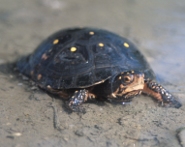
The
Spotted Turtle (
Clemmys guttata) is a small freshwater turtle measuring about 9 to 12.7 cm (3.5 to 5.0 inches) in length and weighing about 8 to 12 ounces (226 to 340 grams). Found mainly along the east coast of the United States, from southern Maine to northern Florida, as well as the Midwest and southern parts of Canada near the Great Lakes, the Spotted Turtle prefers to live in ponds, ditches, swamps and marshes. The Spotted Turtle's shell varies in color from black to bluish black, accented with yellow spots that extend to the legs, neck and head. The Spotted Turtle does not reach maturity until 8 to 10 years of age and the life expectancy of a typical Spotted Turtle is about 25 years.
What makes the Spotted Turtle so fascinating is its eating habits. The Spotted Turtle is an omnivore and will eat a wide variety of foods, from algae and other aquatic vegetation to salamanders, fish, slugs, worms and other small insects. However, the Spotted Turtle will consume its food exclusively in the water. Even if it finds food on land, the Spotted Turtle will return to the water to consume it.
The breeding period for the Spotted Turtle begins in March and ends in May. The female turtles will begin searching for nesting areas at the end of March. Once a proper nesting spot is found, the females will lay only about three to four eggs each. The eggs hatch in about 10 to 12 weeks and the 1-inch (2 cm) hatchlings begin their search for wet, marshy areas to secure food and shelter. Predators of the Spotted Turtle include raccoons,
muskrats,
skunks, otters, bears and eagles. The eggs of the Spotted Turtle are also at risk of being consumed or destroyed by foxes, skunks, raccoons and ants.
However, due to pollution and destruction of natural habitats, the population of wild Spotted Turtles is in decline. The collection of Spotted Turtles for pets has also added to the decrease in population. The Spotted Turtle is listed as an endangered species in Illinois and Ohio, a threatened species in Vermont and Maine, a species of special concern in Indiana and West Virginia, and a protected species in Massachusetts. In Canada, the Spotted Turtle is also listed as endangered and the International Union for Conservation of Nature considers the Spotted Turtle as a species vulnerable to extinction.
You can help spreading the word about this animal by liking it on facebook
Permanent Link
Wednesday 24 July 2013
The Lesser hairy-footed Dunnart - Small but Feisty
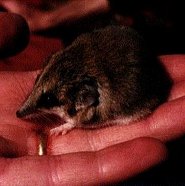
The
Lesser Hairy-footed Dunnart (
Sminthopsis youngsoni) is a tiny furry marsupial about the size of a mouse that is common in the desert areas of Australia including the Northern Territory, Queensland, the top edge of South Australia and Western Australia. It is of the family Dasyuridae and distinguished from the Hairy-footed Dunnart by its less hairy soles and smaller size. Marsupials are different from other mammals because when their young are born they are extremely undeveloped. The young of Lesser hair-footed dunnarts drink their mother's milk from nipples that are in a fold of skin on the stomach that acts as a pouch. They stay close to the mother until they can hunt for insects themselves.
A carnivorous mammal, weighing only 0.01 kg. (0.022 lbs.), it lives up to 5 years and the females have litters of up to 5 or 6 young once a year. Adults can be from 10 to 16 cm. (5 to 7 inches) long. It is usually seen in sandy plains, inter-dune habitats, sand dunes, tussock grasslands, hummock grasslands and open shrubland. They get all the water they need from the insects they eat so they don't require to drink free water.
It is listed in IUCN Red List of Threatened Species with a Least Concern (LR/lc) which is the designation for the lowest risk. There is a large population which lives in a number of protected areas including Uluru National Park and Rudall River National Park, so it is considered unlikely that the numbers will be declining at the rate needed to be listed as threatened. The only threats to the Lesser Hairy-footed Dunnart are not major. They include cats which were introduced to the habitat and frequent, huge fires, but these are considered only localized threats and are not a threat to the species.
It eats mainly insects including grasshoppers and crickets as well as spiders and other invertebrates. Even though it is tiny, the Lesser Hairy-footed dunnart is very brave and will fiercely protect itself if it feels threatened, but if there is no food available they can become torpid.
Picture of the Lesser Hairy-footed Dunnart by
UtherSRG, licensed under
GFDL
You can help spreading the word about this animal by liking it on facebook
Permanent Link
Monday 22 July 2013
The Giant Trevally - The Muscle Car of the Ocean
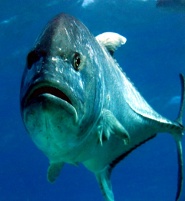
The
Giant Trevally (
Caranx ignobilis) is a powerful oceanic predator fish also known as the GT for short. It’s also called the Giant Kingfish, the Lowly Trevally, or the Barrier Trevally. Like the Mustang GT muscle car, this GT has its own muscle power: strong and thick midsection, and is distinguished by its steep and blunt head shape, and 26 to 38 scutes (sharp, bony plates) along its lateral line. Its color ranges from silver to black, and on those with darker color, it can have remarkable silvery-white patterns on its upper body.
The GT reaches its full size at 3-4 years. Typical size 60 cm long (1.969 feet, or .6 meters) but have been recorded with a length of 170 cm long (5.577 feet, or 1.7 meters) and a weight of 80 kg (176.4 pounds).
The distribution of the Giant Trevally occurs in the tropical or coastal areas of the Indian and Pacific Oceans. The range extends from the eastern coast of Africa, along the coasts of India and Pakistan, across the coast of northern Australia, to as far east as Hawaii. Its habitat is in the shallow coral reefs and lagoons and channels in these tropical areas.
With its canines in its upper jaw, and conical teeth in its lower jaw, the GT has been known to consume small turtles and dolphins. However, its main diet consists of most baitfish found in tropical waters, and it supplements its diet with lobsters, squid, and octopus. The Trevally’s method of operation is to use its muscled body to body slam its prey into stunned submission and then quickly eat before another competitor can take away the spoils. The GT also follows
Monk Seals and reef sharks to their feeding grounds, and waits for when the shark or seal’s attention is diverted, and then grabs what it can of the other predator’s dinner.
The GT is prey to only two other predators: sharks, and man. Its biggest threat is population decline, which is largely suspected as due to erosion of coral reefs, which are the GT’s main habitat. While it remains a popular game fish in the Indo-Pacific region, its numbers have been decreasing around Hawaii. So far, fishing for the Giant Trevally has not been banned but anglers are being encouraged to follow a catch and release method instead. Recommendations are to have the fish out of water for no more than 30 seconds, to use a hose to pump saltwater through the gills, to use barbless hooks, to not hold the fish by just the mouth, gills, or tail, to hold it securely and not allow it to drop or hit against anything, and to gently swim it a bit before releasing it.
You can help spreading the word about this animal by liking it on facebook
Permanent Link
Monday 15 July 2013
Olingo - Expert Jumper
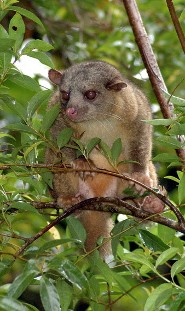
The
Olingo (
Bassaricyon gabbii) is a light brown and cream colored creature that has a length of between 35 and 48 centimeters or 14 and 19 inches and a weight of 10 to 15 kilograms or 22 to 33 pounds. They have tails that are quite long, usually about the length of the body. The Olingo also has a round head and small round ears. The eyes possess large pupils and are typically cinnamon in color. The creature has 40 razor sharp teeth in the form of canines, premolars, and molars.
Olingos typically eat during the night with this diet consisting primarily of fruits, lizards, and insects. The typical predators of the species consist of snakes as well as large cats such as the
jaguar.
The Olingo has no definitive breeding season. The mating is started by the males of the species who produce penetrating and drawn out calls after they detect that a female in heat is nearby. Mating will then take place and will occur numerous times between the two animals.
The animal has an average gestation of 73 days with one birth resulting from the pregnancy. The newborn is deaf as well as blind and has short and sparse hair that is grey-black in color. The newborn is typically about 22 centimeters or 9 inches in length and 55 grams or 2 ounces in weight. The eyes and the ears will typically begin functioning within the first two weeks of life. It becomes fully mature when it reaches the age of 2 years.
It has been difficult for researchers to determine the exact behavior of the Olingo as it typically lives within thick forest environments and are primarily nocturnal, solitary, and arboreal. The creatures typically sleep within the cavities of trees and are excellent jumpers and climbers. In fact, they are able to jump as far as 3 meters from one limb to another. Because of this incredible ability to jump, they are able to often avoid their predators such as snakes and wildcats.
Olingos live in the rainforest located in Northeastern South America and Central America. They primarily live between sea level and 2,000 meters and remain in the tops of trees in the dense forest and they rarely travel from the treetop to the forest floor.
Olingos are quite rare, however, they are rated as IUCN which is the lower risk so they are fortunately not close to being extinct.
Picture of the olingo by Jeremy Gatten, licensed under the
Creative Commons Attribution-Share Alike 2.0 Generic license.
You can help spreading the word about this animal by liking it on facebook
Permanent Link
Friday 12 July 2013
The Bonobo - The Most Sexual Active Apes on Earth
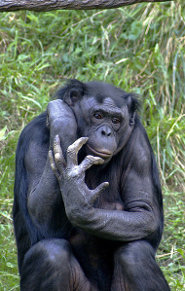
The
bonobo (
Pan paniscus), is one of the closest relatives to humans along with the
chimpanzee. Once called the Pygmy chimpanzee, they live in only one country in the world, the Democratic Republic of Congo. These unique and fascinating creatures of the Congo basin rainforest are an endangered species with only about 5,000 remaining in the wild. The average male bonobo weighs approximately 43 kg or 95 lb, and the average female weighs 37 kg or 82 lb. Heights are 78 cm (31 inches) and 73 cm (29 inches) respectively.
Bonobos sleep in the treetop canopy of the rainforest and do most of their feeding there as well; although, they have been known to forage on the forest floor if necessary. The bonobo diet consists mostly of fruit, but also includes eggs, fungi, and other plants.
These remarkable simian creatures have earned their nickname as a result of their colorful sex lives. Unlike other simians, the bonobo female genitalia is tilted forward much like that of a human female. Because of this, bonobos are capable of face-to-face sex (and any other position, for that matter) much like humans. It is the habit of the bonobo to have sex at least once a day, but frequently several times per day. Unlike any other mammal or primate, bonobos engage in recreational sex, not just the reproductive kind. They have been observed engaging in oral sex, group sex, and deep kissing. They often gaze into one another’s eyes during sex in ways that are impossible for other mammals due to physical limitations.
Bonobos resemble human structure physically more closely than any other primate. Their legs are longer, arms shorter, ears smaller and have a more open facial structure than other simians. This coupled with the structure of the female genitalia mentioned above; make them the closest human relative in the animal kingdom.
Bonobos have no real natural predators except for
humans. Although it is illegal to hunt bonobos, many hunters in the African Congo do so anyway. Some people capture infant bonobos to sell to humans as pets. The nearly constant war in the Congo region has also been a factor in the near extinction level of bonobo population numbers.
Many people have never heard of a bonobo and do not know of their endangerment. Get educated and get involved to help preserve this unique creature.
Picture of the bonobo by Kabir Bakie at the Cincinnati Zoo May 2005, licensed under
Creative Commons Attribution-Share Alike 2.5 Generic
You can help spreading the word about this animal by liking it on facebook
Permanent Link
Wednesday 10 July 2013
Southern Tree Hyrax - Rock Star of the Night
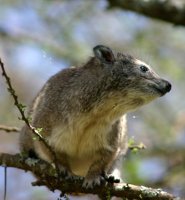
The
Southern Tree Hyrax (
Dendrohyrax arboreus) makes its home in the temperate forests of eastern and southern Africa. It can be found in Angola, Democratic Republic of the Congo, Kenya, Mozambique, South Africa, Tanzania, and Zimbabwe. Also known as the Eastern Tree Dassie, Eastern Tree Hyrax, and Southern Tree Dassie, it is an herbivore, favoring a variety of tree matter (leaves, shoots, and twigs), fleshy fruits, and hard seeds. They have brownish-gray fur with a creamy white patch on their backs marking the location of a dorsal scent gland. The average weight of a Southern Tree Hyrax is 2.27 kg (4.99 lb) and the average length is 520 mm (20.47 in). They have very short, stumpy tails and resemble a marmot or guinea pig in appearance. Genetically, Hyraxes are closely related to the elephant.
The Southern Tree Hyrax spends most of its time in the trees as they are very clumsy on the ground and have difficulty walking. Avoiding the ground may also be a way that they avoid some of their ground-based predators. Their dens are generally made in the hollow of a decaying tree or a nook between two branches. They are nocturnal and mostly solitary, although they can sometimes be found in pairs. They are perhaps the most distinguished for the distinctive, shrieking call of the male Southern Tree Hyrax announcing his territory. It has been described as beginning with a creaking noise, similar to the sound of tightening a ratchet, building to a crescendo, then dropping off to quieter screams.
Hyrax gestation is approximately 7 months, producing 1 to 2 (more often 2) babies. Hyraxes are weaned between 3 and 7 months of age, and sexual maturity is reached around 1 year. The lifespan of a Southern Tree Hyrax is about 10 years.
Known predators are eagles (especially Verreaux eagles which exist almost entirely on Hyraxes),
leopards, lions, jackals,
spotted hyenas, feral dogs, and snakes. In some areas, humans also eat Hyraxes and hunt them for their fur.
The Southern Tree Hyrax is vulnerable to extinction in the wild due to loss of habitat, though it is presently listed as "Least Concern" on the IUCN Red List of Threatened Species.
Picture of the Southern Tree Hyrax by Charles J Sharp, licensed under
GFDL
You can help spreading the word about this animal by liking it on facebook
Permanent Link
Thursday 04 July 2013
The Black Skimmer - Skimming in Flocks
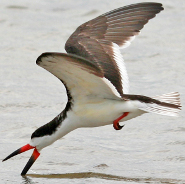
The
Black Skimmer (
Rynchops niger) feeds by skimming the surface of the water with its long lower mandible.
Native to the Americas, the Black Skimmer measures about 40 to 50 cm (15.75 in - 19.70 in) as an adult with a wingspan of 107 to 127 cm (42 in - 50 in). The adult male weighs about 325 grams (11.5 oz) as compared to the smaller female of about 235 g (8.3 oz).
In North America, the Black Skimmer breeds in the warmer waters of the Atlantic and Pacific coasts. In South America, the breed migrates mainly in reaction to seasonal flooding. A seabird, this species inhabits sand or gravel beaches and bars, estuaries, and salt marshes.
In appearance the Black Skimmer resembles a tern and is black on top with white underside. The bill is bright red with black tip, and the long, narrow wings are dark on top and grayish below. The legs and feet are red, while the tail is white with a black center. The bird’s call is a “kak kak kak” or “kur kur kur.”
The Black Skimmer is the only bird species in the United States in which the lower mandible is longer than the upper mandible. Upon hatching, the two mandibles have the same length but henceforth the lower mandible grows until it is much longer than its counterpart. The birds generally feed during the day, flying just over the water’s surface in order to dip their lower mandible and “skim” for prey including
fish, insects and shellfish.
Predators can include dogs, foxes, cats and raccoons, and humans looking for eggs. The eggs are also vulnerable to flooding and ecological disturbance by humans. Human development and traffic along beaches can threaten the bird's nesting grounds, as the species is sensitive to even minor disturbances during breeding.
The species can be divided into three subspecies: Rynchops niger niger, located from southern California to Ecuador on the Pacific coast, and along the North American Atlantic coast; Rynchops niger cinerscens, a larger subspecies located on the Atlantic coast of South America; and Rynchops niger intercedens, also located on the South American Atlantic coast down to Argentina.
The species is listed under the category of Least Concern after a prior rating of Lower Risk. The current population of Black Skimmers is estimated at about 200,000 individual birds, and the population has remained stable for the last decade.
Picture of the black skimmer by Googie man, licensed under
GFDL
You can help spreading the word about this animal by liking it on facebook
Permanent Link
 The Spotted Turtle (Clemmys guttata) is a small freshwater turtle measuring about 9 to 12.7 cm (3.5 to 5.0 inches) in length and weighing about 8 to 12 ounces (226 to 340 grams). Found mainly along the east coast of the United States, from southern Maine to northern Florida, as well as the Midwest and southern parts of Canada near the Great Lakes, the Spotted Turtle prefers to live in ponds, ditches, swamps and marshes. The Spotted Turtle's shell varies in color from black to bluish black, accented with yellow spots that extend to the legs, neck and head. The Spotted Turtle does not reach maturity until 8 to 10 years of age and the life expectancy of a typical Spotted Turtle is about 25 years.
The Spotted Turtle (Clemmys guttata) is a small freshwater turtle measuring about 9 to 12.7 cm (3.5 to 5.0 inches) in length and weighing about 8 to 12 ounces (226 to 340 grams). Found mainly along the east coast of the United States, from southern Maine to northern Florida, as well as the Midwest and southern parts of Canada near the Great Lakes, the Spotted Turtle prefers to live in ponds, ditches, swamps and marshes. The Spotted Turtle's shell varies in color from black to bluish black, accented with yellow spots that extend to the legs, neck and head. The Spotted Turtle does not reach maturity until 8 to 10 years of age and the life expectancy of a typical Spotted Turtle is about 25 years.
 The
The  The
The  The
The  The
The  The
The  The
The